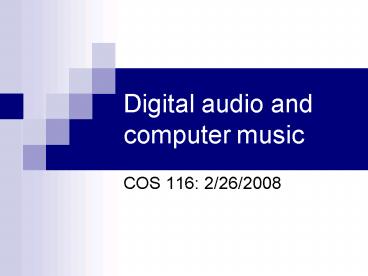Digital audio and computer music - PowerPoint PPT Presentation
Title:
Digital audio and computer music
Description:
Sound and music in the physical world and in human experience. Representations of music ... Pandora.com (human-driven), last.fm. Machine learning for analysis ... – PowerPoint PPT presentation
Number of Views:349
Avg rating:3.0/5.0
Title: Digital audio and computer music
1
Digital audio and computer music
- COS 116 2/26/2008
2
Overview
- Sound and music in the physical world and in
human experience - Representations of music
- Analyzing music with computers
- Creating music with computers
3
1. Sound and music
4
What is sound?
Pressure wave
5
What do we hear?
- Video http//www.youtube.com/watch?v0svoQcMQNYg
- Frequency
- Pitch
- Loudness
- Timbre
6
Psychoacoustics
- Relationships between physical phenomenon of
sound and our perception - Frequency pitch
- 20-20,000Hz
- Amplitude loudness
- Identities and strengths of frequencies present
timbre
7
What is music?
Organized sound
- Psychoacoustics play an important role
- Also dependence upon history, culture,
experience - Engages listeners psychological mechanisms for
expectation/reward
8
2. Representations of sound and music
9
How do you represent music?
- Score
- Audio samples
- Spectrum
10
Digital representation of music
11
Compression
- A better representation with fewer bits
- Why? Security, transmission, storage
- How?
- Psychoacoustic principles
- MP3 Masking
- Physical principles of sound production (uses
modelsof sound source)
12
Choosing a representation
- Representations are compromises
- Standard representations are somewhat arbitrary
- Appropriate representation is task-dependent
13
3. Using technology to analyze sound and music
14
Analyzing speech
- Real-life apps
- Customer service phone routing
- Voice recognition software
15
Computational Auditory Scene Analysis
- Applications Archival and retrieval, forensics,
AI
16
Music information retrieval
- Analyzing musical data
- Query, recommend, visualize, transcribe, detect
plagiarism, follow along with a score - Sites you can try
- midomi.com
- Themefinder.com
- Pandora.com (human-driven), last.fm
17
Machine learning for analysis
18
4. Using technology to create music and sound
- A whirlwind tour of the 20th century, with a
focus on computer technology
19
Creating music Synthesis
20
Three approaches to synthesis
- Additive synthesis
- Figure out which frequencies are present, and in
what proportions - Synthesize a sine wave at each frequency, and
superpose them. - Physical modeling
- Start with knowledge about how physical systems
oscillate - Simulate oscillation of an arbitrary system.
(RecallLecture 4)
21
Three approaches to synthesis
- Cross-synthesis
- Choose filter for speech (vowel)
- Choose source to be another sound
22
Some continua of computer music creation
low
Synthesis
Controlling synthesis
Composition
high
Level of control
23
Performer-Computer Interaction
- Augmented instruments
- Software and hardware interfaces
- Demo PLOrk video, PBS
- Demo using a Wii-mote to control sound
- Demo SMELT
- New instruments
- Demo Perrys Mug
- Live coding
- Demo Maxs drum machine
24
Questions How can we.
- develop new ways to synthesize sound?
- give user control over synthesis parameters?
- make machines interactive in a musical way?
- augment human capabilities?
- design new instruments that are easy to play?
allow expert musicality? - create music that is emotionally and
aesthetically compelling?
25
Final remarks
- Distinctions in this presentation are superficial
- Analysis, representation, and creation interact
- Technology draws on and contributes to our
understanding of the physics and psychophysics of
sound - Computer music is interdisciplinary
- HCI, AI, programming languages, algorithms,
systems building - Also psychology, music theory, acoustics, signal
processing, engineering, physics, performance
practice, library science, applied math
statistics, - Technology is constantly complicating and
changing the landscape of our musical experiences
as creators, participants, listeners, and
consumers.
26
http//soundlab.cs.princeton.edu/































